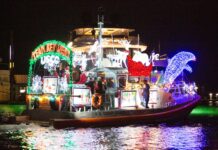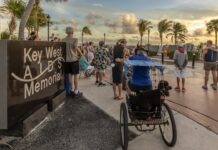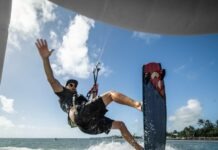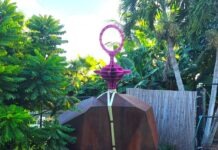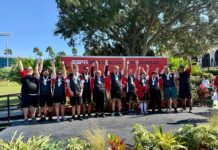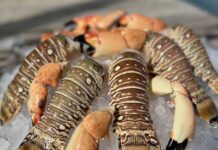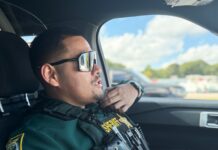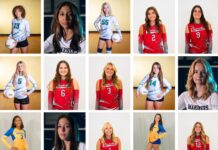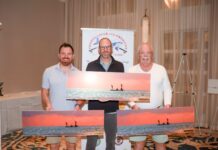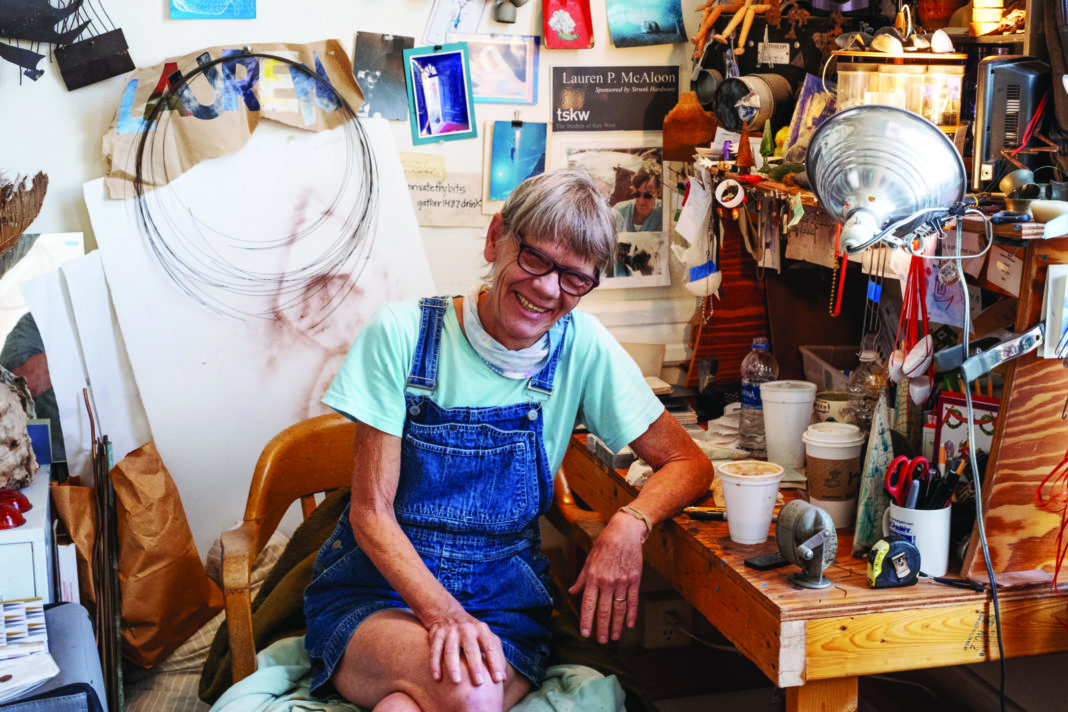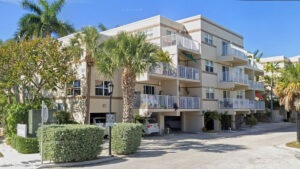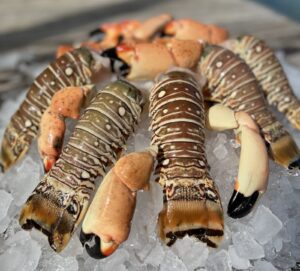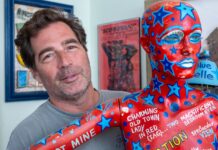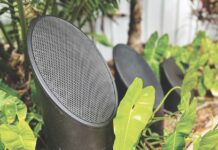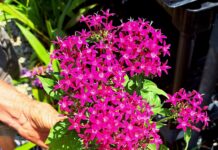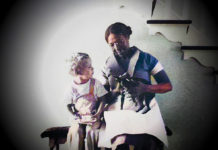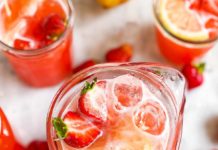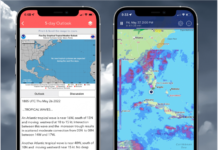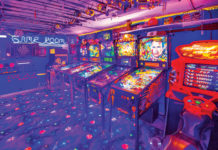Lauren McAloon starts working in her studio most mornings a little after 6:30. She’d probably get there earlier, but she can’t get a con leche – large, no sugar – from Five Brothers before then.
Her studio is on the second floor of the old armory building on White Street – the yellow, turn-of-the-last-century building with the turrets and the long skinny windows. It’s 300 square feet of space with a small number of work tables, a set of wooden shelves that reach like rickety skyscrapers towards the 16-foot ceilings and one not-particularly-stable chair.
It’s a proper, busy artist’s space, stuffed with spools of wire, wooden hoops, pipe organ pedals, royal palm fronds, washed up pieces of coral, iron bed frames, ladders, colored glass balls, tree stumps, cigar boxes, barbed wire, string, fan chain pulls, scrap wood, a small army of foot-high hardwood posing as manikins, and a lone pink ballet slipper, still in its wrapping. What doesn’t fit on a shelf or table gets hung on the wall.
There are also at least eight or 10 works in progress.
McAloon works in short bursts, an hour or two a session, refining and reshaping a piece until she feels it is right. Occasionally a finished piece will end up in a group show, or on commission in a gallery. More often than not a red dot, indicating the piece is sold, will appear next to it before most people have a chance to lean in and see the price.
Late in her morning, early in everyone else’s, she heads into The Studios of Key West, where she’s worked as the gallery and facilities manager since its creation in 2007, maintaining multiple buildings, managing improvements, and hanging up to four exhibitions a month with a deft sensitivity to the work that most artists describe with a giddy reverence. (She’s hung four of my shows. Before one opening, she repainted the same wall three times until she felt it was the right shade of gray to go with my images.)
Boats and their parts have long been the predominant theme in McAloon’s work. Often her pieces will be a single vessel, usually elongated and narrow. Often they will look to be made of found pieces of driftwood, or carved chunks of unfamiliar minerals, though they are all actually ceramic, specifically high-fired stoneware. These pieces are usually combined with sheafs or loops of wire that suspend the boats’ hulls over an invisible sea.

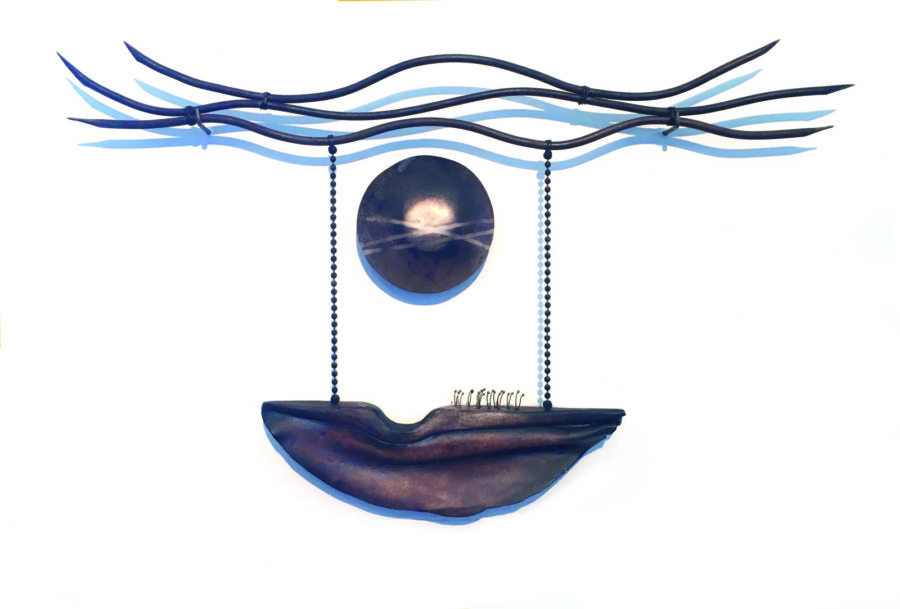
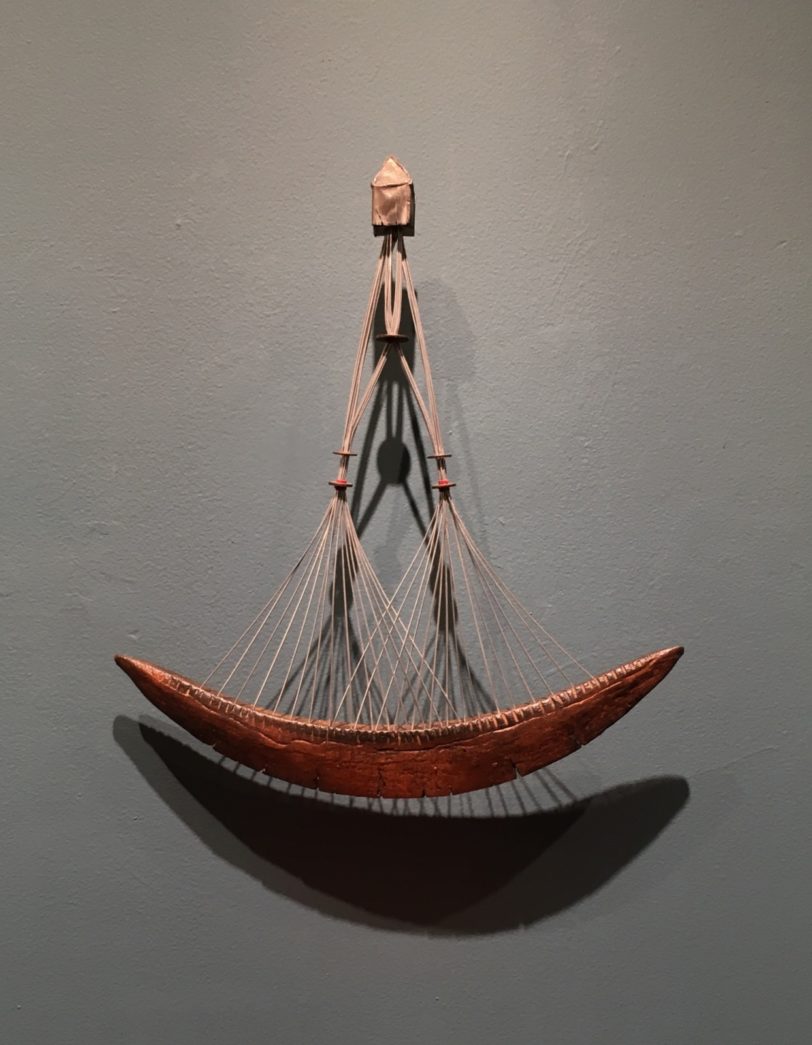
Her work tends to look simultaneously modern, ancient and timeless.
“The boats all started because I had clay, and I dropped it on the floor, and it was such an elongated shape, I was like, whoa,” said McAloon. “So then I started purposely flinging it. It’s basically my version of throwing vessels, or boats.”
“I find the shape really sexy. Boat shapes, especially working boats, have references for journeys and travel and voyages and history. A lot of my work has a historical base to it. Immigration and migration — by choice or not — really pulls at me. With the boat shapes, I can use that shape and then manipulate it to then evoke what I’m thinking about,” she said.
“I don’t like to use the word symbolic. I like to use the word reference. There are multiple layers to a lot of my works. For me, it’s important that they are just visually strong. But if you are the kind of person who likes to go deeper into something, there’s definitely layers and layers of meaning — to me — that most of the pieces have,” said McAloon.
Sometimes there will be an array of vessels, repeated shapes that form visual chords and harmonies.
Sometimes there will be improvised materials, such as an oar from a Cuban chug — a rustic, homemade vessel used by migrants – combined with, say, taillight covers from old American cars, and more ceramic vessels.
“I was actually having a drink at a bar in town, and a bunch of people were talking about migrants and stuff like that. A guy came in, and he started asking me, ‘What’s with the boats, Lauren?’ And I said, ‘OK, everyone here, how did your family get to the U.S.? And it was, well my uncle came – or my great grandfather came – on a boat from Italy. The next person – by boat from Poland. And the next person, by boat from… by boat from… by boat from…”
McAloon pointed out that unless you’re an American Indian or you and/or your family migrated more recently, your people most likely came by boat.
“A lot of people, their history is rooted in someone making a decision to step onto – or being forced to step onto – a boat. To me that’s such a common thread. It’s amazing. Amazing,” she said.
McAloon herself arrived in Key West by car, on Christmas Eve in, she thinks, 1990, though maybe it was 1991. She and her husband Brendan drove from Portsmouth, New Hampshire after enduring the loss of five immediate family members in five years.
“It got to the point where you just didn’t want to answer the phone anymore,” she said. They left Portsmouth when “everybody remaining sort of seemed healthy.”
The plan was to work in Key West for a few months to earn enough money to head south to the islands.
“We were totally expecting dirt roads. So we were driving into Key West and there’s the old Kentucky Fried Chicken,” she said. “We were like, ‘Oh my God, where’s a U-turn?’”
They persevered, though, and made it to Full Moon Saloon that first night, then spent a week at the hostel for $13 a night.
“And then we got off of Duval Street and into the neighborhoods and realized we really liked it,” she said.
To get jobs, they realized they needed a phone. To get a phone, they realized they needed an apartment. So they rented one, where they stayed for close to 30 years. (Brendan passed away in 2016.)
In New England, McAloon had mostly managed kitchens and worked as a cook on tugboats. (She had her Merchant Marine license.) She worked a number of jobs in Key West before she ended up running the fish department at the former Waterfront Market for 13 years, a job, she said, that actually prepared her for work at The Studios of Key West.
“You had to really display things, it was important, so people could see the different things. But also, it all had to do with texture and color,” McAloon said. “It was the same as putting up exhibitions. You get 120 pieces by 120 different artists, and you want to make it so things relate to each other in some way, whether it’s color or subject matter. That there’s a flow through the space that’s comfortable for people. It was a good primer for all that,” she said.
McAloon came from a family of makers. Her father was a Bauhaus-trained architect who also designed and built sailboats. Her mother was a painter and illustrator who once worked for Joyce Ballantyne, the painter of pin-up girls, as well as the original Coppertone ad – the one with the dog tugging on a little girl’s bathing suit. McAloon said she made things her whole life, but mostly just to entertain herself. In Key West she created elaborate costumes for the Green Parrot Halloween Party, as well as a series of kites that hung on the ceiling of the old Bamboo Room on Appelrouth Lane.
What she felt was her first real piece – or at least the piece that changed her trajectory – was a weathervane she’d created while taking a welding class at Florida Keys Community College (now The College of the Florida Keys). She’d slipped a photo of it – which was the silhouette of a dancing woman trailed by stars – under the door at Harrison Gallery and ended up in Sculpture Key West, an outdoor art show that used to fill Fort Zachary Taylor with sculptures for a few weeks a year.
She became one of the stalwarts of the then-annual event. Her installation “The Gathering” at West Martello Tower, was inspired by the story of the three slave ships that were illegally en route from Africa to Cuba in 1860, but were intercepted by the US and brought to Key West. (This was before the current African Memorial was in place at Higgs Beach.)
She’d been struck by the stories of how the town came together to clothe and feed the Africans that were aboard the intercepted slave ships. The installation included elements such as wind- activated aeolian flutes created from large bamboo trunks as well as blue glass bottles on the fence spikes, referencing a tradition she’d seen in the South where blue bottles surrounded graves or were hung in trees as a way to distract and trap evil spirits.
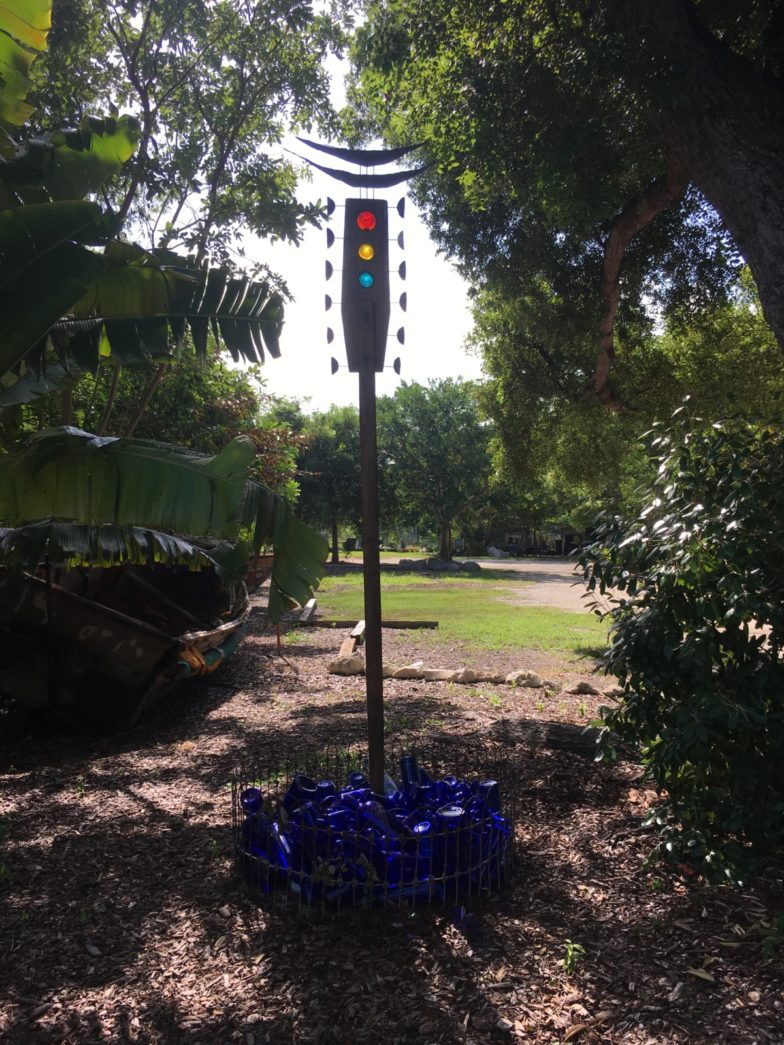
A few years later her installment “Threshold” included 48 aeolian flutes – each one representing how many years, at the time, the United States’ Cuban embargo had been in effect. There were also a series of steel and iron rudders, salvaged from Cuban chugs, rising up out of the water onto the beach. It’s a work that people who saw it at the time still think about.
“The rudders were brought to me from Fort Jefferson by the rangers out at the Dry Tortugas. I was still at the Waterfront Market at the time, and I would see the rangers coming in carrying another rudder that they had gotten. It took me five or six years to finally come up with a piece that really, I thought, respected those rudders. They have a pretty amazing energy to them,” she said.
In the years since she’s had her own studio, McAloon’s work has gotten smaller in scale and more intimate. A large part of that has been space and time – the thing that has caused her to work in early one- or two-hour bursts. But all that will be changing soon.
McAloon will be giving up both her role at The Studios of Key West in the coming months, as well as her 300-square-foot studio at the armory. She’s not leaving town, but moving to a 1,000-square-foot space on Stock Island, one that will allow her to work on larger, more complicated pieces.
“I have no idea what’s gonna happen. I’m so used to working on my artwork in little snippets. I start spinning after that. It’s such a habit. To have full days, it’s gonna be interesting to see what happens. The last time I ever had that chance was for a period of about four weeks in 2005,” she said, then laughed.
McAloon said she is also preparing herself to find new sources for con leche. She said there’s El Mocho on Maloney Avenue, but there’s also a new place that looks interesting on Third Avenue.
“I’ve got enough ceramic pieces at this point to keep me busy for a while. There are also some larger pieces – that aren’t necessarily related to boats – that I’ve just really been champing at the bit to work on. And now I’ll have space,” she said.
